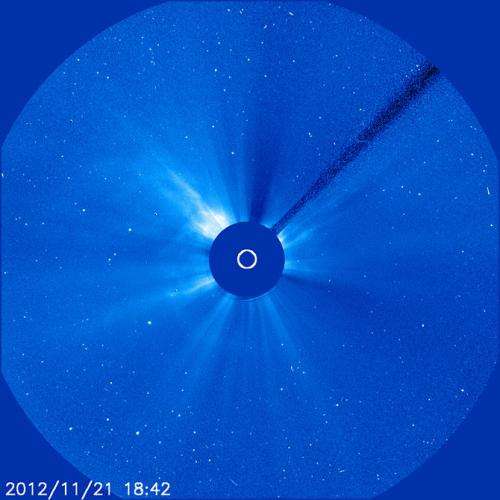NASA spacecraft observe a Thanksgiving CME

(Phys.org)—On Nov. 21, 2012, at 11:24 a.m. EST, the sun erupted with an Earth-directed coronal mass ejection or CME. Experimental NASA research models, based on observations from the Solar Terrestrial Relations Observatory (STEREO) and the ESA/NASA mission the Solar and Heliospheric Observatory, show that the Nov. 21 CME left the sun at speeds of 500 miles per second, which is a slow to average speed for CMEs.
Not to be confused with a solar flare, a CME is a solar phenomenon that can send solar particles into space and can reach Earth one to three days later. When Earth-directed, CMEs can cause a space weather phenomenon called a geomagnetic storm, which occurs when CMEs successfully connect up with the outside of the Earth's magnetic envelope, the magnetosphere, for an extended period of time. In the past, CMEs of this speed have not usually caused substantial geomagnetic storms. They have caused auroras near the poles but are unlikely to cause disruptions to electrical systems on Earth or interfere with GPS or satellite-based communications systems.
NOAA's Space Weather Prediction Center (swpc.noaa.gov) is the United States Government official source for space weather forecasts. According to the SWPC website:
"SWPC forecasters expect G1 (Minor) to G2 (Moderate) geomagnetic storming beginning midday on November 23rd. The Coronal Mass Ejection (CME) was associated with a solar flare from NOAA Region 1618 that peaked at the R1 (Minor) level on November 21 at 1530 GMT (1030am EST). Region 1618 continues to grow and has potential to produce more activity in the coming days."
Provided by NASA





















